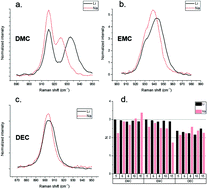Solvation behavior of carbonate-based electrolytes in sodium ion batteries†
Abstract
Sodium ion batteries are on the cusp of being a commercially available technology. Compared to lithium ion batteries, sodium ion batteries can potentially offer an attractive dollar-per-kilowatt-hour value, though at the penalty of reduced energy density. As a materials system, sodium ion batteries present a unique opportunity to apply lessons learned in the study of electrolytes for lithium ion batteries; specifically, the behavior of the sodium ion in an organic carbonate solution and the relationship of ion solvation with electrode surface passivation. In this work the Li+ and Na+-based solvates were characterized using electrospray mass spectrometry, infrared and Raman spectroscopy, 17O, 23Na and pulse field gradient double-stimulated-echo pulse sequence nuclear magnetic resonance (NMR), and conductivity measurements. Spectroscopic evidence demonstrate that the Li+ and Na+ cations share a number of similar ion–solvent interaction trends, such as a preference in the gas and liquid phase for a solvation shell rich in cyclic carbonates over linear carbonates and fluorinated carbonates. However, quite different IR spectra due to the PF6− anion interactions with the Na+ and Li+ cations were observed and were rationalized with the help of density functional theory (DFT) calculations that were also used to examine the relative free energies of solvates using cluster – continuum models. Ion–solvent distances for Na+ were longer than Li+, and Na+ had a greater tendency towards forming contact pairs compared to Li+ in linear carbonate solvents. In tests of hard carbon Na-ion batteries, performance was not well correlated to Na+ solvent preference, leading to the possibility that Na+ solvent preference may play a reduced role in the passivation of anode surfaces and overall Na-ion battery performance.



 Please wait while we load your content...
Please wait while we load your content...